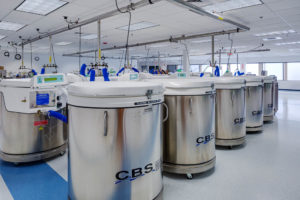The Value of Long Term Cord Blood Storage
Parents who have banked their child’s cord blood for many years may question whether it’s worth continuing to store their child’s umbilical cord blood (UCB) unit. While that is a personal choice for each family, we do know that the need for cord blood treatment sometimes arises later in life. For example, patients may develop hematological disorders well into adulthood. In that circumstance, parents may wonder how long their UCB unit can be stored, and how well it will survive the thawing process.
Once stem cells reach the NECBB laboratory, they are carefully prepared to tolerate cryopreservation storage. To ensure that umbilical cord blood
remains in viable condition while in storage, UCB units are stored at temperatures of -196°C. Careful cryopreservation and constant monitoring ensures that the cells survive the freezing process, indefinite storage, and the thawing process, should they ever need to be used.
 How long can cord blood be stored?
How long can cord blood be stored?
With the proper preservation and storage techniques, it is possible to store UCB cells for decades in a frozen state and then recover it for use. In practice, UCB cells have been used successfully after having been stored for more than 20 years.³ In theory, it is possible that properly stored stem cells could outlive us all.
In 2011, researchers from the Indiana University School of Medicine and Johns Hopkins University compared the function of recovered stem cells that had been frozen for nearly 24 years to their condition prior to freezing. The researchers found that they could recover 80%-100% of the stem cells. In addition, cells that had been cryopreserved for as long as 21 years were able to be used in successful treatment.⁴
High-quality preservation strategies and precise storage methods continue to offer the best opportunity for successful use of cord blood units after an indefinite period of cryostorage. UCB banking provides a once-in-a-lifetime opportunity to preserve cells that offer enormous potential in the treatment of over 80 diseases and conditions. Research continues on, evaluating cord blood stem cell treatment of both hematological and non-hematological disorders, including immune disorders and metabolic disorders. Researchers are also investigating cord tissue stem cells in potential stem cell therapies for macular degeneration, type 1 diabetes, neurological disorders, and more.